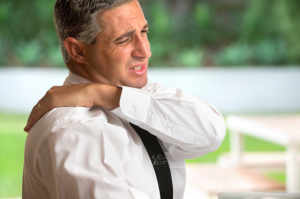Nick Rinard Physical Therapy continues to get patients results with “practical and effective treatment” since 1996!
Getting patients better in as little as 3 visits with only an average of 6-8 visits per patient.
“After a hit + run accident on my bile, I have spent the last year recovering to the point where I could focus on a shoulder injury.
The orthopedic surgeon referred me to PT and I am delighted that after only three visits, my range of motion has returned and my pain has disappeared.
Thanks to the office staff for promptly scheduling me + to the PT for practical and effective treatment.”
Jennifer
More
By Nick Rinard MPT, Cert MDT
09 Jun, 2014
Clinical Case of the Week
abduction, chronic, dosed loading, dysfunction, falling, flexion, remodeling, shoulder pain, suprapinatus
 Patient is a 60 y/o male “Mike” with chronic shoulder pain. Mike’s symptoms started in 1994 after falling onto his left shoulder. Overall, his symptoms had been unchanging and severely affecting his job. He has had previous physical therapy and massage therapy to no avail. He was severely limited with lifting, carrying and working out.
Patient is a 60 y/o male “Mike” with chronic shoulder pain. Mike’s symptoms started in 1994 after falling onto his left shoulder. Overall, his symptoms had been unchanging and severely affecting his job. He has had previous physical therapy and massage therapy to no avail. He was severely limited with lifting, carrying and working out.
During his initial evaluation, it was found that Mike had painful, limited range of all shoulder movements with the exception of lateral rotation. He also had weak/painful resisted tests of shoulder abduction, medial rotation and flexion. His most limited impairment was painful, weak abduction.
It was determined that Mike had chronic dysfunction of the supraspinatus muscle tendon (one of the rotator cuff muscles). Because of the anatomical position of this tendon, it is the most commonly injured and torn of the rotator cuff. Mike began remodeling his tendon with targeted, dosed loading. By the next visit, he was strong, in less pain and had improved range of motion.
Mike continued his remodeling exercises for the next 4 weeks. By his 6th visit to our Portland clinic he had virtually no pain and was no longer limited with his work or life from his shoulder pain. Mike is a classic example of how conservative treatment that targets the root of the problem results in fast, effective results!
Don’t wait 20 years to have your simple problem solved. Have a mechanical evaluation at Nick Rinard Physical Therapy today!
More
This is about a shoulder derangement that was identified, and fixed in 10 minutes. But there is more background to the story.
Debbie (a fictitious name for the real person) was training for her first 1/2 Marathon, held in Portland, Oregon. About 3 weeks before the event she presented to physical therapy complaining of pain behind the knee. Such an injury so close to a sporting event is automatically worrisome because it threatens participation. Both Debbie and I were concerned that it could stop her from being able to run the 1/2 marathon!
I performed a mechanical assessment per the McKenzie Method, combined with Cyriax style selective tissue tension tests, and diagnosed the knee pain as “semitendinosis tendinitis”, named according to Laslett nomenclature. It is a lesion of the hamstring.
Although Debbie had good hamstring flexibility, I deduced, based on her history (she was certified as a yoga instructor), that she normally had more. Treatment consisted of stretching out her hamstrings, combined with manual deep tissue mobilization of the hamstring muscle belly. It worked!
She ran the 1/2 Marathon without any knee pain! However, her shoulder became painful during the event! She asked me to look at it 4 days later since it had not subsided on its own.
She presented with what appeared to be a clear contractile lesion of the infraspinatus tendon, with a weak resisted test of lateral rotation. However, there were two pieces of information that were inconsistent with this conclusion. 1) Resisted shoulder flexion was painful with the elbow positioned behind the body, but painless with the elbow in front. 2)
There was no tenderness at all near the infraspinatus tendon, which would be typical , but not required, for the lesion to be harbored in the infraspinatus tendon.
Further mechanical assessment was needed, and this followed the McKenzie Method of Mechanical Diagnosis and Therapy. Repeated tests would differentiate between a derangement and other possible pathologies. I surmised that the arm bone could have been malpositioned in the shoulder girdle from Debbie pumping her arms while running. The logical step was to reverse the activity of arm pumping and correct the derangement. So I instructed her to reach all the way across her body with that arm and then push it further using the other hand. This became less and less painful until there was no pain! Furthermore, it resulted in much less pain produced by resisted flexion afterward! Another exercise–that of rotating the arm bone back into place–worked well also, virtually rendering all prior painful tests, painless!
Needless to say, Debbie was very pleased with both the rapid results with her shoulder, and grateful that her knee pain was treated in time for her to complete her 1/2 marathon!
More

